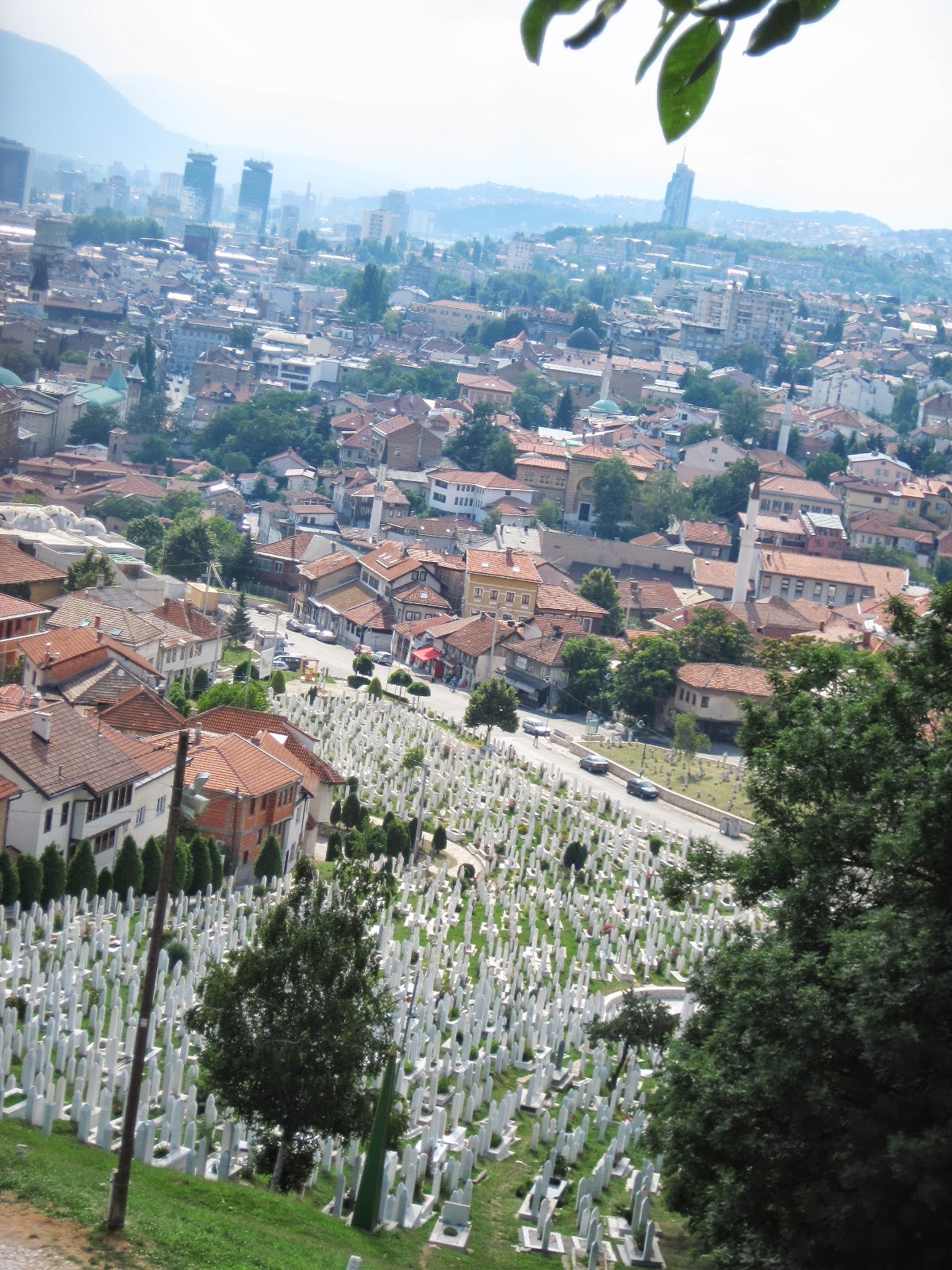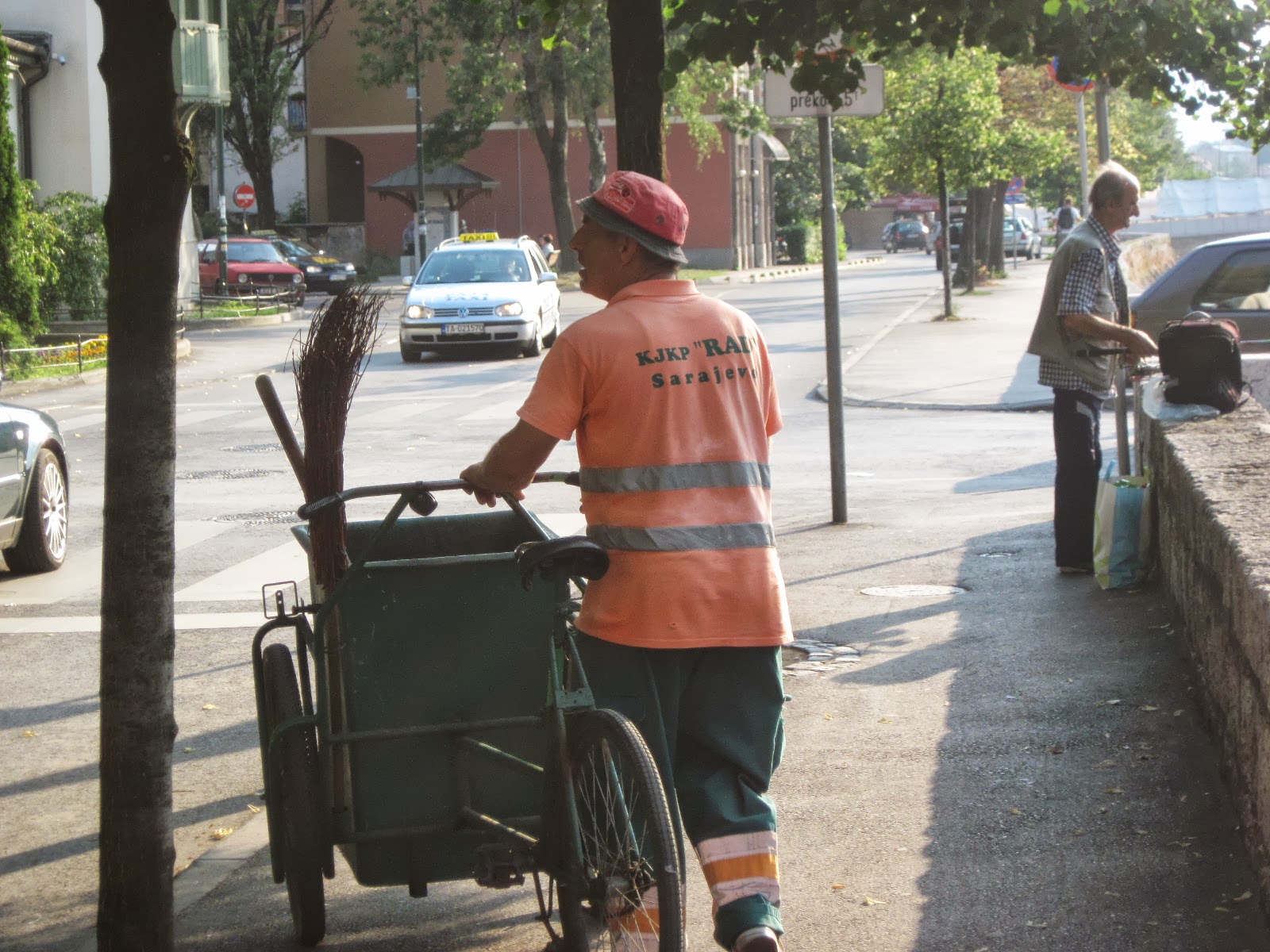7/25 Thursday
Through the day, we’re joined by a
couple of young women from Denmark, and a group of five, guys and girls, from
Turkey, students travelling through Europe on their summer break.
We
plan a walking tour though the old city to follow a sight-seeing path on our
tourist map. The first stop is the Cathedral on our corner. The interior is
beautiful, with the columns and arches built with the banded stone design
that’s typical of Eastern architecture. There’s a nun at the doorway turning
anyone away wearing a tank top or overly revealing clothes.
We
go to the large Gazi-Husrev Bey mosque at the center of the city, where we can visit
the adjacent madrassa for an historical exhibit. This is also the site of a
gorgeous new library, holding a collection of historical manuscripts, books and
documents originally established in 1537. The exhibit in the madrassa rooms tells
the history of Gazi-Husrev Bey, a military leader, scholar and benefactor who
was influential in developing Sarajevo as an important center of commerce and
culture in the Ottoman Empire. We meet a nice man from Kuwait, an architect
with his degrees from the University of Miami, who explains some of the Arabic
terminology for us.
Our
walk continues through the metal-workers alley, where the workshops are full of
intricate and beautiful coffee services, trays, water jugs and more, copper and
silver shining in the afternoon sun.
The
tour is suddenly derailed as we pass a little restaurant, sort of a diner,
where the food is all displayed at a counter and you can pick out what you
want. There’s a platter of roast chicken and potatoes calling out to Bob “WAIT,
DON’T LEAVE ME!!” So we have a bite for lunch. The waitress is understandably
grumpy, working in the kitchen with an open oven of charcoal fires.
Our
next stop is the Assassination Museum, or Museum of the City of Sarajevo,
depending on your guidebook. It’s a one-room exhibit in the building right at
the spot where an assassin killed the heir to the Austro-Hungarian throne,
Archduke Franz Ferdinand and his wife, Sophie, an event that essentially
caused WWI. The museum chronicles the events of the assassination, displays
some photos and artifacts, and also describes the early transformation of the
city, languishing despite its former glory under the Ottoman Empire to a newly
revived industrialized capital under the Austro-Hungarian government. It’s all
very interesting, and makes us want to learn more about the history.
From
here, we leave the Old City for a climb up the surrounding streets to the old
fortress. Not much is left but a wall, but everyone comes up for the fort view,
overlooking the whole city and its valley. It’s quite striking. We can see
fields of tombstones all throughout the city, many of them from the recent war
years.
We
can also see our next stop, the Sarajevska Pivara, the Brewery. When the Austro-Hungary
government acquired Sarajevo from the Ottoman Empire in the 1860’s, they began
a campaign of industrialization throughout the city, bringing in the
afore-mentioned tram system, a brickyard, tobacco factory, and this brewery.
The brewery was one of a few businesses that sort-of functioned during the
siege, but when people would wait in lines to get some water from the brewery’s
source, they were often struck by mortar fire.
The
brewery pub is just as it should be: dark wood beams, high brick vaulted
ceilings, elaborate chandeliers, low lighting. It’s just quitting time as we
walk up, and the brewery workers are leaving for the day. I ask for a beer
menu, and the waiter says “This is Sarajevska Brewery, we have Sarajevska
Beer.” So I gathered. They brew light, unfiltered light, and dark. We have a
light lager and one unfiltered lager. Then we sit back to enjoy the beers and
the atmosphere.
On
our way home, we pass a few street cleaners. Everywhere we’ve been in these
Eastern European cities, there’s been a lot of effort put into keeping the streets
clean. There were small street vacuum trucks running through the streets of
Prague, and shopkeepers sweeping off their storefront sidewalks. City workers
trim the hedges and rosebushes and plant decorative flower beds. What’s strange
to see are the sweeper’s brooms. They are actual bunches of branches, just like
Cinderella’s. We wonder if they make their own, or if there’s a city
broom-maker somewhere.
1 Video Included
Sarajevo Brewery











No comments:
Post a Comment